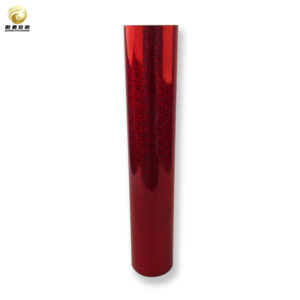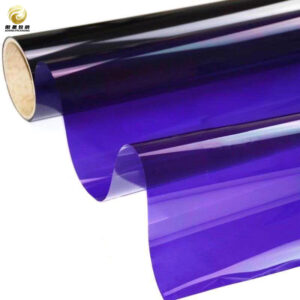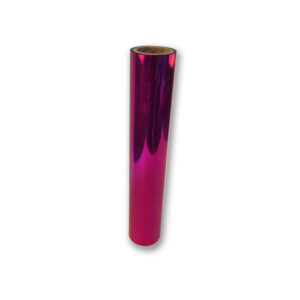Holographic Lamination Film
| Product | Transparent PET Film |
| Material | PET + color+ aluminum layer / PET + aluminum + color layer |
| Thickness | 12~188um |
| Color Option | Red,Blue,Purple,Green,Gold,Yellow,Rose,Rainbow,etc. |
| Width & Length | Width:500~1800mm Length:Customized |
Detailed Descriptions
Holographic lamination film is a specialized type of film that is used to enhance the appearance and durability of various surfaces. Unlike regular lamination film, which is typically transparent or matte, holographic lamination film features a mesmerizing holographic pattern that reflects light in a captivating manner. This unique characteristic makes holographic lamination film an excellent choice for adding a touch of elegance and intrigue to products such as packaging, labels, ID cards, and more.
How is Holographic Lamination Film Made?
The manufacturing process of holographic lamination film involves several intricate steps. It begins with the creation of a master hologram, which is made by exposing photosensitive material to laser light interference patterns. This master hologram is then transferred onto a nickel shim through an electroforming process. The nickel shim serves as a mold for the holographic pattern. Next, a layer of adhesive is applied to the base film, followed by the transfer of the holographic pattern from the nickel shim onto the adhesive layer. Finally, a protective coating is added to ensure the longevity and durability of the holographic lamination film.
Benefits of Using Holographic Lamination Film
| Benefits of Using Holographic Lamination Film |
|---|
| Enhanced visual appeal |
| Increased durability and protection |
| Improved resistance to water, chemicals, and UV light |
| Reduced risk of counterfeiting and tampering |
| Cost-effective solution for packaging and labeling |
| Easy to apply and compatible with various printing techniques |
One of the primary benefits of using holographic lamination film is its increased durability. The protective coating on the film helps to prevent scratches, tears, and other forms of damage, ensuring that the underlying surface remains intact and pristine. Additionally, holographic lamination film offers enhanced visual appeal. The mesmerizing holographic pattern adds depth and dimension to any design, making it visually striking and captivating. This can be particularly advantageous for businesses looking to create eye-catching packaging or promotional materials.
Another significant advantage of holographic lamination film is its ability to provide protection against tampering and counterfeiting. The holographic pattern is difficult to replicate, making it an effective deterrent against unauthorized duplication or alteration of documents, labels, or products. This added layer of security can be crucial for industries such as pharmaceuticals, electronics, and luxury goods, where counterfeiting is a prevalent issue.
Applications of Holographic Lamination Film
Holographic lamination film finds applications in a wide range of industries. In the packaging industry, it can be used to create attention-grabbing boxes, bags, and labels that instantly capture the consumer’s interest. In the printing industry, holographic lamination film can be applied to book covers, brochures, and business cards to add a touch of elegance and sophistication. It is also commonly used in the production of ID cards, driver’s licenses, and passports to enhance security features and prevent forgery.
Moreover, holographic lamination film has found its way into the world of fashion and accessories. From clothing tags and shoe boxes to jewelry packaging and gift wrapping, holographic lamination film adds a luxurious and glamorous touch to these products. Additionally, it is increasingly being used in the automotive industry for decorative purposes on car interiors and exteriors.
Types of Holographic Lamination Film
There are several types of holographic lamination film available in the market today. Each type offers a unique holographic pattern and visual effect. Some common types include rainbow holographic film, which displays a vibrant spectrum of colors; dot matrix holographic film, which creates a pixelated pattern; and 3D holographic film, which gives the illusion of depth and movement. The choice of holographic lamination film depends on the desired effect and the specific requirements of the project.
Factors to Consider When Choosing Holographic Lamination Film
When selecting holographic lamination film, there are several factors to consider. The thickness of the film is an important consideration, as it determines the level of protection and durability it provides. Thicker films are generally more robust but may be less flexible. The adhesive type is another crucial factor, as it determines how well the film adheres to the surface and how easy it is to apply. Additionally, the application method should be taken into account, as some films require heat or pressure for proper adhesion, while others can be applied manually.
How to Use Holographic Lamination Film
Using holographic lamination film is a straightforward process that can be done by anyone with basic knowledge and tools. To apply the film, start by cleaning the surface thoroughly to ensure proper adhesion. Cut the holographic lamination film to the desired size, leaving a small margin for easy handling. Peel off the protective backing from the adhesive side of the film and carefully align it with the surface. Apply even pressure to ensure proper adhesion, using a roller or squeegee if necessary. Trim any excess film and smooth out any air bubbles or wrinkles for a flawless finish.
To achieve the best results when using holographic lamination film, consider a few tips and tricks. Firstly, make sure to work in a clean and dust-free environment to prevent particles from getting trapped under the film. Secondly, take your time during the application process to ensure accurate alignment and avoid mistakes. Lastly, experiment with different lighting conditions to fully appreciate the mesmerizing holographic effect of the film.
Maintenance and Care of Holographic Lamination Film
To maintain the quality and longevity of holographic lamination film, it is essential to follow proper cleaning and storage guidelines. When cleaning the film, use a soft, lint-free cloth or sponge and a mild detergent or cleaning solution. Avoid using abrasive materials or harsh chemicals, as they can damage the holographic pattern or the protective coating. After cleaning, gently pat the film dry with a clean cloth to prevent water spots or streaks.
When storing holographic lamination film, keep it in a cool, dry place away from direct sunlight and extreme temperatures. Avoid folding or creasing the film, as this can cause permanent damage to the holographic pattern. If possible, store the film in its original packaging or in a protective sleeve to prevent scratches or other forms of physical damage.
Future of Holographic Lamination Film
As technology continues to advance at an unprecedented pace, the future of holographic lamination film looks promising. Researchers and manufacturers are constantly exploring new ways to improve the quality, versatility, and sustainability of holographic films. One potential advancement is the development of thinner films that offer the same level of protection and visual appeal while reducing material waste. Additionally, advancements in printing techniques may allow for more intricate and detailed holographic patterns, opening up new possibilities for creative applications.
Furthermore, with the increasing demand for eco-friendly solutions, there is a growing focus on developing holographic lamination films that are biodegradable or made from recycled materials. This shift towards sustainability aligns with the global efforts to reduce plastic waste and minimize environmental impact.
Why Holographic Lamination Film is a Great Choice
In conclusion, holographic lamination film is an excellent choice for businesses and individuals looking to add a touch of elegance, durability, and security to their projects. With its mesmerizing holographic pattern, holographic lamination film enhances visual appeal and captivates the viewer’s attention. Its increased durability and protection against tampering make it a valuable asset in various industries, from packaging and printing to identification and security.
As technology continues to evolve, holographic lamination film is expected to become even more versatile, sustainable, and visually stunning. With advancements in manufacturing techniques and a growing focus on eco-friendly solutions, holographic lamination film will continue to be a smart investment for businesses and individuals alike. So, whether you’re looking to create eye-catching packaging, secure important documents, or simply add a touch of magic to your projects, holographic lamination film is the perfect choice.
FAQs
What is holographic lamination film?
Holographic lamination film is a type of film that is used to laminate and protect printed materials such as documents, ID cards, and packaging. It has a holographic pattern that gives it a unique and attractive appearance.
How is holographic lamination film made?
Holographic lamination film is made by embossing a holographic pattern onto a thin layer of polyester film. The film is then coated with an adhesive and a release liner is added to protect the adhesive until it is ready to be used.
What are the benefits of using holographic lamination film?
Holographic lamination film provides a high level of protection against tampering, counterfeiting, and forgery. It also enhances the visual appeal of the laminated material, making it more attractive and eye-catching.
What types of materials can be laminated with holographic lamination film?
Holographic lamination film can be used to laminate a wide range of materials including paper, cardboard, plastic, and metal. It is commonly used to laminate ID cards, passports, banknotes, and packaging.
How is holographic lamination film applied?
Holographic lamination film is applied using a laminating machine. The material to be laminated is placed between the layers of the film and fed through the machine. The heat and pressure from the machine activate the adhesive, bonding the film to the material.
Is holographic lamination film environmentally friendly?
Holographic lamination film is not considered to be environmentally friendly as it is made from non-biodegradable materials. However, some manufacturers are developing eco-friendly alternatives that are made from biodegradable materials.
#!trpst#trp-gettext data-trpgettextoriginal=1975#!trpen#Productos relacionados#!trpst#/trp-gettext#!trpen#
-

#!trpst#trp-gettext data-trpgettextoriginal=1247#!trpen#Leer más#!trpst#/trp-gettext#!trpen#Hologram PET Film -

#!trpst#trp-gettext data-trpgettextoriginal=1247#!trpen#Leer más#!trpst#/trp-gettext#!trpen#Clear Plastic Film -

#!trpst#trp-gettext data-trpgettextoriginal=1247#!trpen#Leer más#!trpst#/trp-gettext#!trpen#Transparent Polyester Roll -

#!trpst#trp-gettext data-trpgettextoriginal=1247#!trpen#Leer más#!trpst#/trp-gettext#!trpen#Metalized plastic film




